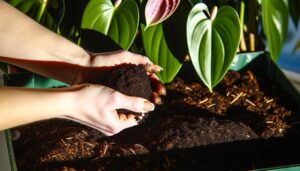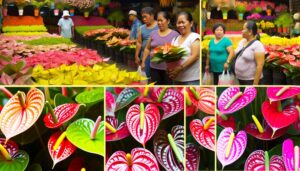Complete Guide to Anthurium Dressleri Care
Caring for Anthurium Dressleri involves bright, indirect light and maintaining temperatures between 70-85°F. Water it when the top inch of soil is dry using room-temperature, filtered water.
Maintain humidity levels between 70-80% with a humidifier or tray. Use a well-draining soil mix with orchid bark, perlite, and peat moss, and choose a pot with multiple drainage holes.
Prune with sterilized shears and regularly inspect for pests, using mild soap or neem oil if needed. Proper drainage prevents diseases like root rot, and you can propagate using stem cuttings, division, or seeds.
For detailed guidance, further information awaits.
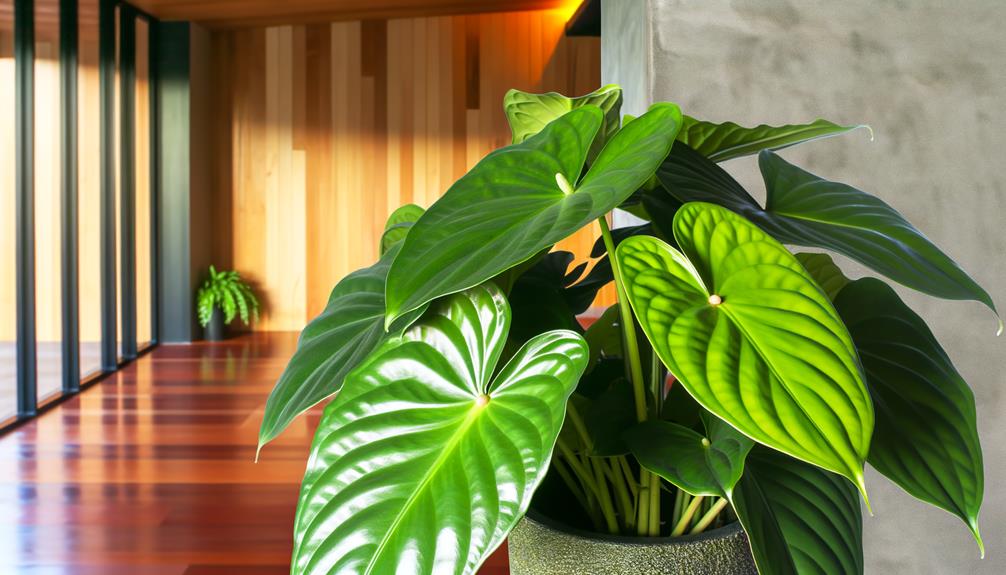
Key Takeaways
- Place Anthurium Dressleri in bright, indirect light near north or east-facing windows, avoiding direct sunlight.
- Water when the top inch of soil is dry using room-temperature, filtered water, ensuring the pot has drainage holes.
- Maintain temperatures between 70-85°F and humidity levels between 70-80%, using a humidifier or humidity tray if needed.
- Use a well-draining soil mix with orchid bark, perlite, and peat moss, and repot every two years.
- Prune dead or damaged leaves with sterilized shears and inspect regularly for pests and diseases, acting promptly if detected.
Ideal Lighting Conditions

Do you know that Anthurium Dressleri thrives best in bright, indirect light to mimic its natural tropical habitat? Position it near a north or east-facing window where it can soak in filtered sunlight.
Direct sunlight may scorch its delicate leaves, so avoid placing it in direct paths of sun rays. Use sheer curtains to diffuse intense light if necessary. Fluorescent grow lights can also be beneficial, especially during shorter winter days.
Rotate the plant every few weeks to promote balanced growth through even light distribution. Remember, the goal is to replicate the dappled light conditions of its native rainforest environment.
Watering Schedule
Maintaining a consistent watering schedule is crucial for the health of your Anthurium Dressleri. Water it once the top inch of soil feels dry to the touch. Use room-temperature, filtered water to avoid any potential chemical damage.
Confirm the pot has drainage holes to prevent waterlogging, which can lead to root rot. Water thoroughly until you see water draining from the bottom, then allow the soil to dry out slightly before the next watering.
During warmer months, you may need to water more frequently, while in cooler periods, reduce the frequency.
Always monitor the plant’s response and adjust accordingly. Mist the leaves occasionally to maintain humidity, but avoid over-watering as it can harm your Anthurium Dressleri.
Temperature Requirements
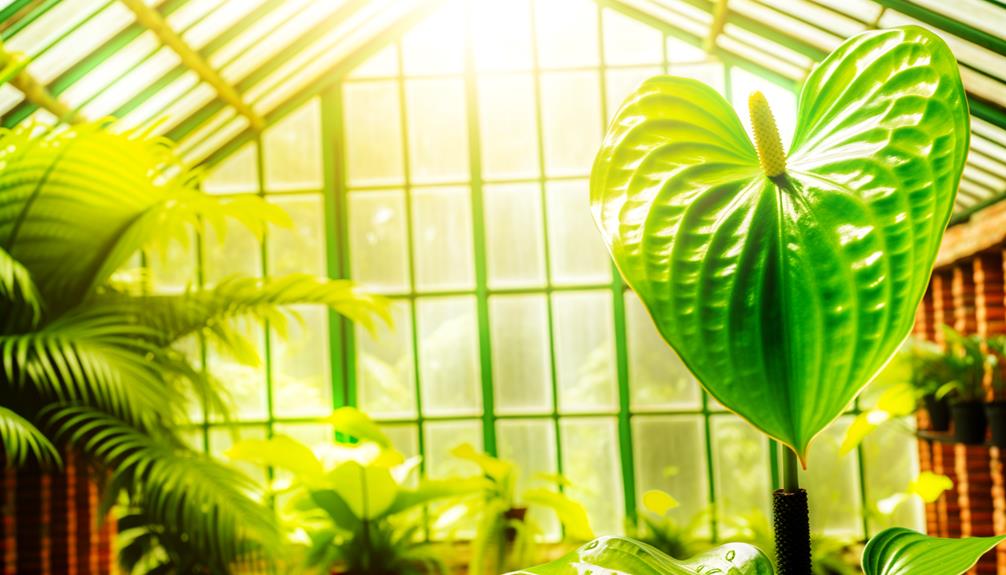
To guarantee your Anthurium dressleri thrives, maintain an ideal temperature range between 70-85°F.
You should adjust temperatures seasonally, keeping it slightly cooler during the winter months.
Always avoid exposing the plant to temperature extremes, as this can cause stress and hinder its growth.
Optimal Heat Range
For best development, Anthurium dressleri thrives in a temperature range between 70°F and 85°F.
Maintaining this range ensures the plant’s metabolic processes function at their best, supporting vibrant foliage and healthy blooms. It is crucial to monitor temperature closely, particularly during seasonal changes, to prevent stress.
| Temperature (°F) | Plant Response |
|---|---|
| Below 70°F | Slowed growth, potential stress |
| 70°F – 85°F | Optimal growth and health |
| Above 85°F | Increased risk of leaf burn |
Keeping your Anthurium dressleri within this ideal range will help you provide the best care possible.
Avoid placing the plant near drafts, heaters, or air conditioning vents, as these can create temperature fluctuations that might harm the plant.
Seasonal Temperature Adjustments
During seasonal changes, you should adjust the temperature settings to make certain Anthurium dressleri stays within its best range. This tropical plant thrives most between 70-85°F (21-29°C).
In the winter, maintain your home temperature above 60°F (15°C). Use a reliable thermometer to monitor the ambient temperature regularly. If needed, employ a space heater to maintain warmth, but avoid placing it too near to the plant to prevent foliage damage.
Conversely, during summer, make sure the temperature doesn’t surpass 85°F (29°C). Proper ventilation and occasional misting can help keep the plant cool.
Avoiding Temperature Extremes
Maintaining your Anthurium dressleri within its ideal temperature range is crucial for preventing stress and promoting robust growth. Strive to keep the temperature between 70-85°F (21-29°C) during the day and no lower than 60°F (15°C) at night.
Avoid placing your plant near drafts, air conditioners, or heating vents, as sudden temperature fluctuations can be harmful. If you live in an area with harsh winters or hot summers, consider using a thermostat-controlled environment or relocating the plant indoors when necessary.
Regularly monitor the temperature with a reliable thermometer to maintain consistency. By upholding a stable environment, you’re nurturing a healthy, thriving Anthurium dressleri that will reward you with its beautiful foliage and flowers.
Humidity Levels
Maintaining high moisture levels, ideally between 70-80%, is important for the best growth of Anthurium Dressleri. You can achieve this by using a humidifier, placing the plant on a humidity tray, or grouping it with other plants.
Monitor moisture levels with a hygrometer to keep them at their best. Dry air can cause leaf browning and stunt growth. Here’s a quick reference table to help:
| Moisture Level | Method | Benefits |
|---|---|---|
| 70-80% | Humidifier | Consistent moisture |
| 60-70% | Humidity tray | Moderate improvement |
| Below 60% | Plant grouping | Slight boost in moisture |
Maintaining these levels will optimize your Anthurium Dressleri’s growth, providing lush foliage and vibrant development.
Soil Preferences
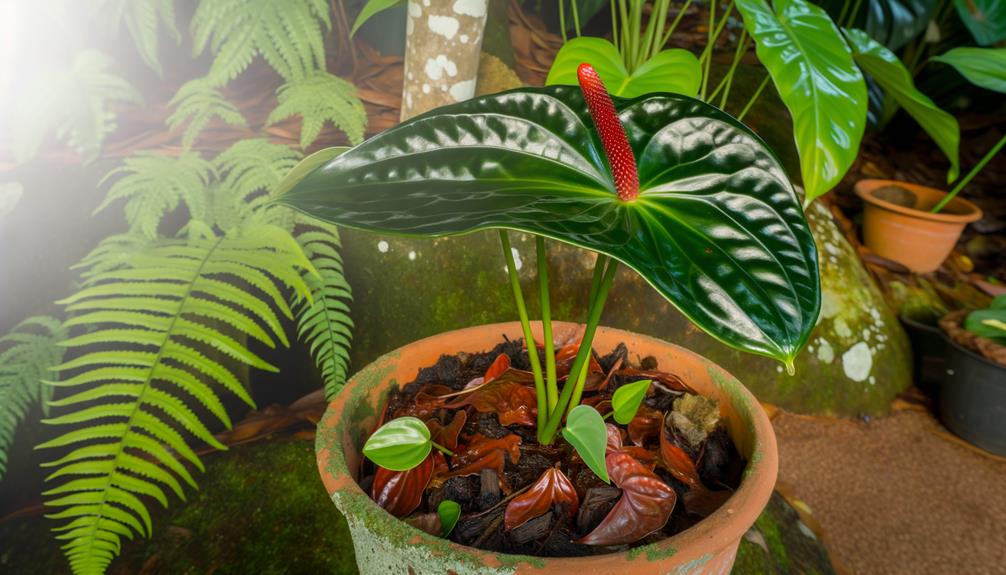
When selecting soil for your Anthurium Dressleri, prioritize a mix that guarantees both excellent drainage and best aeration.
You’ll want a blend that combines orchid bark, perlite, and peat moss to mimic its natural environment.
This composition prevents waterlogging and promotes healthy root growth.
Ideal Soil Composition
Anthurium Dressleri thrives in a well-draining soil mix rich in organic matter to mimic its natural tropical habitat. You’ll want to create a blend that retains moisture without becoming waterlogged.
Use a mix that includes:
- Orchid bark – Provides excellent drainage and aeration.
- Perlite – Enhances soil structure and prevents compaction.
- Peat moss – Adds organic matter and retains moisture.
- Charcoal – Helps to absorb impurities and keep the soil fresh.
These components guarantee your Anthurium Dressleri receives the right balance of nutrients, moisture, and air.
Always mix these ingredients thoroughly to create an ideal growing environment.
Drainage and Aeration
To promote optimal growth, it’s crucial to maintain excellent drainage and aeration in the soil mix for your Anthurium Dressleri.
Begin with a blend of orchid bark, perlite, and peat moss. This combination guarantees that the roots don’t remain in water, reducing the chances of root rot. Orchid bark provides structure and aeration, while perlite improves drainage.
Peat moss holds the correct amount of moisture without getting waterlogged. You can also include charcoal to assist in keeping the soil fresh.
Make sure the pot has drainage holes to permit excess water to escape. Regularly monitor the soil’s moisture levels and adjust watering practices as necessary.
Fertilization Tips
Consistently feeding your Anthurium dressleri with a balanced, water-soluble fertilizer will guarantee robust growth and vibrant foliage.
Opt for a fertilizer with a ratio like 20-20-20, and dilute it to half strength to avoid over-fertilization. Apply the fertilizer every four to six weeks during the growing season, typically from spring to early fall.
To ensure optimal fertilization, follow these steps:
- Water thoroughly before fertilizing to prevent root burn.
- Apply the fertilizer during the morning to maximize nutrient absorption.
- Monitor for yellowing leaves, as this indicates either deficiency or excess.
- Flush the soil periodically to remove salt buildup from fertilizers.
Potting and Repotting

When potting your Anthurium dressleri, choose a pot with good drainage to prevent waterlogging.
Use a well-aerated soil mix, such as a blend of orchid bark, perlite, and peat moss, to mimic its natural habitat.
Repot every two years or when the roots outgrow the current pot to promote healthy growth.
Choosing the Right Pot
Choosing the appropriate pot for your Anthurium dressleri is crucial for promoting proper root development and preventing waterlogging.
When picking a pot, focus on these key factors:
- Drainage Holes: Always select a pot with multiple drainage holes to avoid water accumulation, which can result in root rot.
- Size: Choose a pot that’s 1-2 inches larger in diameter than the current root ball. A pot that’s too big may retain excess moisture.
- Material: Terracotta pots are preferred as they provide better airflow and moisture evaporation compared to plastic.
- Stability: Make sure the pot is robust enough to uphold the plant’s growth and occasional repotting.
Best Soil Mix
To safeguard your Anthurium dressleri thrives, use a well-draining soil mixture rich in organic material. Combine equal parts of orchid bark, perlite, and peat moss.
This combination ensures proper aeration, moisture retention, and nutrient availability. Avoid heavy, dense soils that can suffocate roots.
When potting, choose containers with drainage holes to prevent waterlogging. Repot your Anthurium every 2-3 years, or when roots outgrow the pot. Gently remove the plant, shake off old soil, and trim any damaged roots.
Position it in the new pot, filling around with fresh soil mixture. Water thoroughly after repotting to help settle the soil.
Using the right soil mixture and repotting method will promote healthy growth and vibrant foliage for your Anthurium dressleri.
Pruning Techniques
Pruning Anthurium Dressleri involves carefully removing dead or damaged leaves to promote healthy growth and aesthetic appeal. Start by sterilizing your pruning shears to prevent disease transmission.
When pruning, follow these steps:
- Identify dead or damaged leaves: Look for yellowing, browning, or wilted foliage.
- Cut at the base: Make a clean cut at the stem’s base, close to the main plant, but avoid cutting into the healthy tissue.
- Remove spent flowers: Snip off wilted blooms to encourage new growth.
- Inspect regularly: Check your plant every few weeks for any new signs of decay or damage.
This routine helps keep your Anthurium Dressleri vibrant and thriving, ensuring it remains a beautiful addition to your space.
Pest Control

After ensuring your Anthurium Dressleri is well-pruned, it’s important to address potential pest issues that could threaten its health.
First, inspect your plant regularly for common pests like spider mites, aphids, and mealybugs. Use a magnifying glass to spot these tiny intruders. If you find any, gently wipe the leaves with a damp cloth soaked in a mild soap solution.
For severe infestations, consider using insecticidal soap or neem oil, following the product instructions carefully.
Additionally, keep your Anthurium in a well-ventilated area to reduce humidity, which attracts pests. Avoid overwatering, as soggy soil can become a breeding ground for pests.
Common Diseases
Anthurium Dressleri is susceptible to several common diseases, including root rot, bacterial blight, and fungal leaf spots. To keep your plant healthy, you must identify and manage these issues promptly.
Root rot typically occurs due to overwatering or poor drainage. Bacterial blight manifests as water-soaked lesions on leaves and stems. Fungal leaf spots appear as dark, necrotic areas on foliage.
To prevent these diseases, follow these steps:
- Ensure proper drainage: Use well-draining soil and pots with drainage holes.
- Monitor watering habits: Allow the top inch of soil to dry before watering.
- Maintain air circulation: Place the plant in an area with good airflow.
- Inspect regularly: Check for early signs of disease and act swiftly.
Propagation Methods
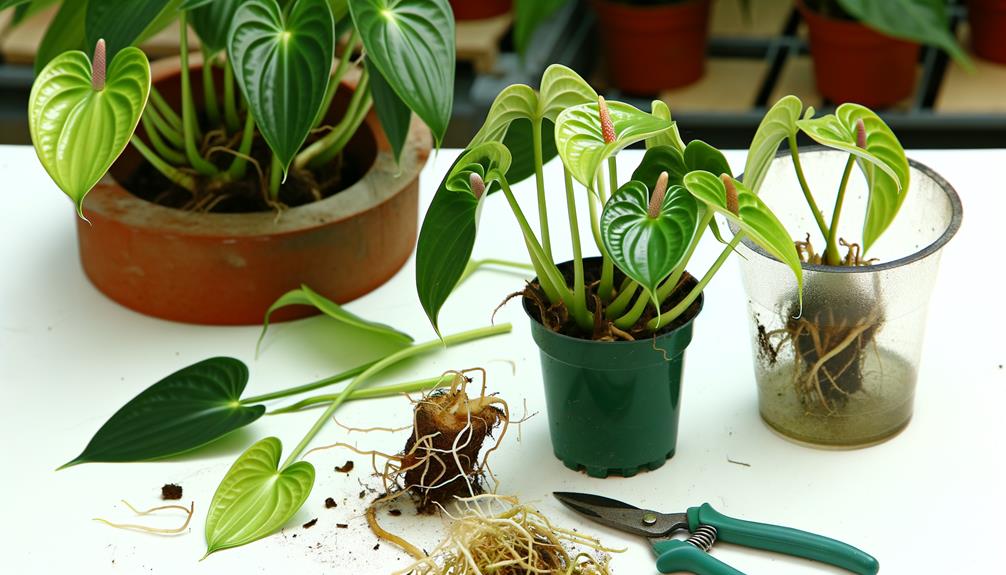
To propagate Anthurium Dressleri effectively, you can use methods such as stem cuttings, division, or seed propagation. Stem cuttings involve snipping a healthy stem with at least one node and planting it in moist, well-draining soil.
Division requires gently separating a mature plant into multiple sections, making sure each has roots and shoots.
Seed propagation is more challenging and requires patience, as seeds need a warm, humid environment to germinate.
Here’s a quick comparison of these methods:
| Method | Key Steps |
|---|---|
| Stem Cuttings | Snip stem, plant in soil |
| Division | Separate plant, ensuring roots and shoots |
| Seed Propagation | Sow seeds, maintain warm and humid environment |
Choose the method that best fits your situation to expand your Anthurium collection successfully.
Seasonal Care
Proper seasonal care guarantees your Anthurium Dressleri thrives year-round by adapting your watering, lighting, and fertilizing routines to the changing conditions.
During the spring and summer, increase watering frequency to keep the soil consistently moist but not waterlogged. In fall and winter, reduce watering to prevent root rot.
Modify lighting to promote optimal growth:
- Spring/Summer: Provide bright, indirect light.
- Fall/Winter: Ensure ample light, possibly supplementing with grow lights.
During Spring/Summer, fertilize bi-weekly with a balanced, diluted fertilizer. In Fall/Winter, reduce fertilization to once a month.
Always monitor humidity levels, aiming for 60-80%, especially during dry winter months.
Conclusion
Caring for your Anthurium dressleri is like tending to a delicate symphony. Each element—lighting, water, temperature, humidity, soil, pest control, disease management, and propagation—plays a crucial note in the harmony of its growth. By mastering these aspects, you guarantee your plant thrives, resonating with vibrant health.
Think of your Anthurium as a living melody, requiring your attentive tuning to flourish. With dedication, you’ll witness each season unfold like a beautiful, well-composed piece.



